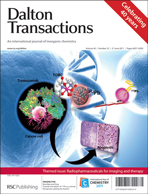Investigating the binding properties of porous drug delivery systems using nuclear sensors (radiotracers) and positron annihilation lifetime spectroscopy—Predicting conditions for optimum performance
Abstract
Understanding how the size, charge and number of available

- This article is part of the themed collection: Radiopharmaceuticals for imaging and therapy

 Please wait while we load your content...
Please wait while we load your content...